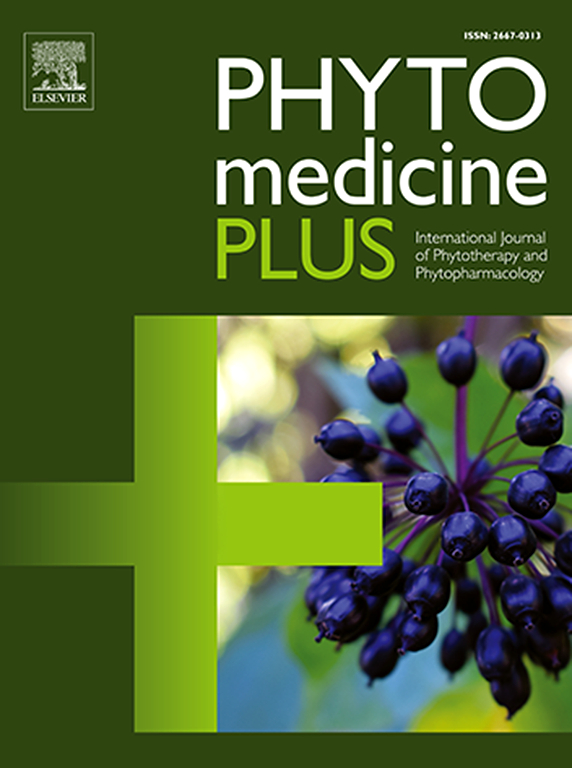Evaluation of antioxidant, anxiolytic and antidepressant potential of Saurauia roxburghii Wall. Leaves: Supported by in vitro, in vivo, and in silico approaches
Q3 Pharmacology, Toxicology and Pharmaceutics
引用次数: 0
Abstract
Saurauia roxburghii, locally known as Dalup, has been utilizing as a treatment for Asthma, Bronchitis, Central Nervous System (CNS) Depression, Eczema, Fever, Gout, Hepatitis B, Piles, and Ulcers by inhabitants from hill-tract of Bangladesh for many years. Blended scientific approaches were applied to evaluate the antioxidant and neuropharmacological activities of the methanol extract of Saurauia roxburghii Wall. Leaves (MSRL) followed by experimental and in silico analysis. Firstly, the qualitative phytochemical screening, acute toxicity study and antioxidant activity assays were conducted. Then elevated plus maze, hole board, hole cross, open field, forced swimming, and tail suspension tests for neuropharmacological potentials were also investigated. Finally, molecular docking and ADMET analysis were carried out based on the bioactive compounds identified by GC-MS profiling. MSRL exhibited moderate antioxidant activity with a substantial amount of antioxidant components in different in vitro assays. In the Elevated Plus Maze and Hole Board test, a higher dose of MSRL (400 mg/kg) exhibited a significant reduction in anxiety-like behavior evidenced by enhanced time spent and entries into open arms, and an increase in the number of head dips, respectively suggesting anxiolytic activity. Moreover, dose-dependent locomotor activity was observed by MSRL in both Open Field and Hole Cross tests. In terms of Forced Swimming and Tail Suspension tests, both doses (200 and 400 mg/kg) of MSRL significantly declined the immobile time of mice indicating antidepressant effects. Lastly, in molecular docking analysis, amongst the identified compounds in GC-MS analysis, 5-(piperidin-1-ylmethyl)-3-pyridin-3-yl-5,6-dihydro-4h-1,2,4-oxadiazine showed strongest binding affinity against all the targeted receptors (Potassium channels receptor, GABAA receptor, and human serotonin transporter) followed by satisfactory ADMET profiling. So, S. roxburghii might have the potential to be used as a prominent source of novel therapeutics for anxiety and depression justifying the traditional usage.

刺梨的抗氧化、抗焦虑和抗抑郁潜力评价。叶片:通过体外、体内和计算机方法支持
孟加拉山区居民多年来一直将刺梨作为治疗哮喘、支气管炎、中枢神经系统(CNS)抑郁症、湿疹、发热、痛风、乙型肝炎、痔疮和溃疡的药物。采用综合科学方法对刺梨甲醇提取物的抗氧化活性和神经药理活性进行了评价。叶片(MSRL)进行了实验分析和硅分析。首先,进行了定性植物化学筛选、急性毒性研究和抗氧化活性测定。并对高架+迷宫、孔板、孔交叉、野外、强迫游泳、悬尾等实验进行神经药理学电位测定。最后,根据GC-MS图谱鉴定的生物活性化合物进行分子对接和ADMET分析。在不同的体外实验中,MSRL表现出中等的抗氧化活性,含有大量的抗氧化成分。在高架迷宫和孔板测试中,高剂量的MSRL (400 mg/kg)显示出焦虑样行为的显著减少,证据是花费的时间和进入张开的手臂的时间增加,以及头部下降的次数增加,分别表明焦虑活性。此外,通过MSRL在Open Field和Hole Cross试验中观察到剂量依赖性的运动活动。在强迫游泳和悬尾实验中,两种剂量(200和400 mg/kg)的MSRL均显著缩短小鼠的静止时间,显示出抗抑郁作用。最后,在分子对接分析中,在GC-MS分析中鉴定的化合物中,5-(哌啶-1-甲基)-3-吡啶-3-酰基-5,6-二氢-4h-1,2,4-恶二嗪对所有目标受体(钾通道受体、GABAA受体和人血清素转运体)的结合亲和力最强,ADMET分析结果令人满意。因此,刺蒺藜可能有潜力成为治疗焦虑和抑郁的新疗法的重要来源,证明其传统用途是合理的。
本文章由计算机程序翻译,如有差异,请以英文原文为准。
求助全文
约1分钟内获得全文
求助全文
来源期刊

Phytomedicine Plus
Medicine-Complementary and Alternative Medicine
CiteScore
3.70
自引率
0.00%
发文量
178
审稿时长
81 days
期刊介绍:
 求助内容:
求助内容: 应助结果提醒方式:
应助结果提醒方式:


